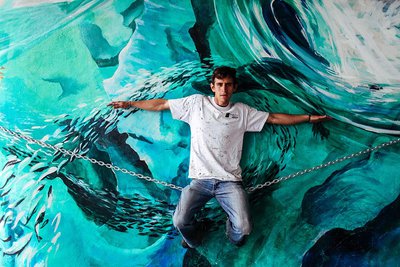
Esteban Camacho weaves through the skateboard jungle that is the new WJ Skatepark + Urban Plaza, finding some smooth invisible path while I stumble after him, jumping out of the way of teens on wheels. It’s clear the artist is a seasoned veteran of the site. We sit on a bench carved into a ramp, skateboarders whirring around us. Hands leathery with green paint, Camacho points up at the murals developing on two pillars buttressing I-105.
“I have a vision of presenting the skatepark and the skateboarders, like the movement that’s happening in this park, but in the context of different natural ecosystems,” he says. “The different animals — the salmon, the trout, the birds — the idea is that they are kind of emulating the movements.”
This spring the city of Eugene put out a call to artists to create murals for the pillars at the new WJ Skatepark as part of the 1 Percent for Art ordinance, which stipulates that any city capital construction project exceeding $50,000 directs 1 percent of those funds to art. Thirty-five artists applied and eight artists were paid a stipend of $375 to produce proposals. Two artists were then chosen by a committee chaired by Public Art Manager Isaac Marquez, and including skater and skateboard instructor Honey Girl, artist and teacher Ellen Tykeson, Whiteaker neighborhood resident Justin Lanphear and Emily Proudfoot and Carrie Petersen of the Parks and Open Spaces department.
Each artist received $17,000 for the project, from which the artist must purchase general liability insurance and materials as well as renting scaffolding and lifts. Camacho began working onsite May 15; the other finalist is currently in the design process.
The painted murals are the first commissioned by the city of Eugene since 1989, when E. Nelson Sandgren completed “Northwest Passages” at the Eugene airport. “We have avoided doing murals as public art commissions because they are very expensive to maintain. It’s a struggle, I’ll be honest with you, to really adequately maintain the public art we have,” Marquez tells me over coffee downtown.
Several factors convinced Marquez to take up this mural project. “The spirit of the place is one,” he says, adding that the city’s new Cultural Services Director Tomi Anderson was another. “With that sort of changing of the guard, you see the world through a new lens.” Lastly, it was the fact that the overpass protects the pillars from the elements.
“I held out on mural art for so long, and then we opened the gate and the best people came through the door,” Marquez says. Initially the committee was unsure how Camacho’s environmental themes would tie into skateboarding culture, Marquez says, but Camacho explained that the skatepark has a young demographic, and the climate change crisis is something they will inherit. “This is the issue that is in their face,” Marquez says.
Back at the skatepark, Camacho turns his attention to the eastern pillar — glowing with rich orange and green brushstrokes, a gray M.C. Escher-esque structure rises from a tangle of grasses and vines into rays of sunlight. “I wanted to bring the elements of the freeway bridge because this is sort of our infrastructure that makes Eugene not sustainable,” he says over the din of skateboards hitting pavement. “It’s sort of metaphorical of the human-built environment.”
Camacho has made a career out of environmental murals. His dreamlike work — valentines to planet Earth — can be seen around Eugene in the courtyard of South Eugene High School and on the north wall of Arriving by Bike, as well as in Portland, Kentucky, Spain and Costa Rica, where he lives part of the year.
But for a tough subject matter like climate change, the murals are strikingly serene. The skatepark murals feature American kestrels perched on craggy cliffs (inspired by the Skinner Butte columns) alongside mountain goats, bald eagles soaring next to a castle-like iceberg, a skateboard nestled in the sand of an emerald river — pillars of calm in a world of chaos.
Part of that chaos includes working in this bustling and undulating concrete landscape, a first for Camacho. “I have to get scaffolding in addition to the lift because these ramps pose an extremely challenging accessibility to a lot of areas,” he says, gesturing to the steel supports positioned precariously next to the skatepark’s deep bowl. “It’s really worth having an assistant.”
Local artist Jessilyn Brinkerhoff has been volunteering on the mural; additionally, Camacho says some of the transient population around the park helped with the initial phase of taping off parts of the pillars. Involving the community, Camacho and Marquez say, will hopefully make others invested in the mural and deter people from tagging.
“I can’t do anything about it. If they do it, I’m going to be frustrated. I just think it makes sense for them to tag everything else,” Camacho says with a smile.